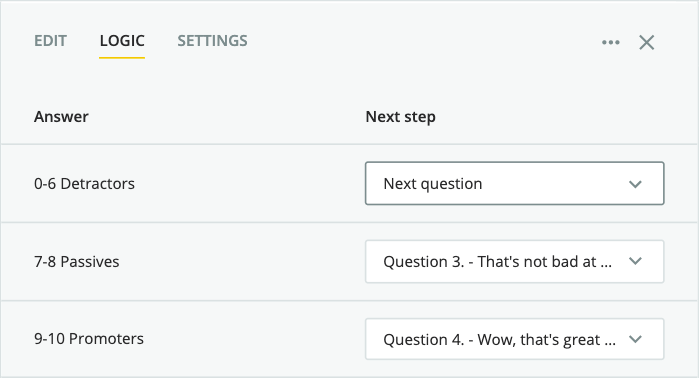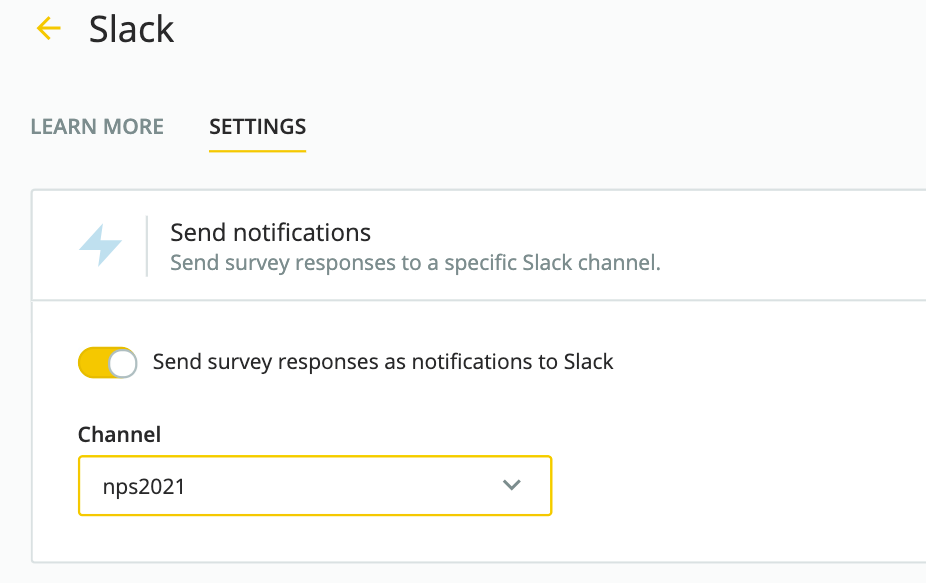In today's busy market, companies compete with customer experience more than their products. The problem is, many fail at understanding what “good customer experience” really means.
A lot of professionals tend to think that to satisfy their customers, they need to razzle-dazzle them. But it’s not like that at all.
What the customers really need is smooth, effortless experience.
The thinking behind the NPS survey is consistent with this aim:
There’s data to prove this, too. According to Harvard Business Review, a study of more than 75,000 companies revealed that wow-ing customers has much less impact than quick problem-solving and effortless use.
To find out what your customers want and when they encounter friction, you need to talk to them. The best way to do it is to use customer surveys.
But there’s a catch. You don’t want the surveys to become yet another friction in customer experience. You need to make them short and sweet but still gather the right data to improve your business.
Enter: the Net Promoter Score (NPS) survey—the easiest way to gauge customer loyalty and predict company growth.
In this article, you’ll learn all there is to know about NPS to create the most efficient survey:
- What's a Net Promoter Score?
- Why do you need an NPS survey for your business?
- What's a good Net Promoter Score?
- How to collect and read your NPS?
- What are the NPS questions?
- What are the NPS best pracitces?
Read on!
What Is a Net Promoter Score?
Net Promoter Score® (NPS) is a popular CX (customer experience) metric that measures clients’ sentiment towards the brand based on the answers to one question: “How likely are you to recommend [company X] to a friend or colleague?”. It’s typically distributed in a survey form.
Free-to-Use NPS Survey Template
Although seemingly simple, NPS is a complex customer experience metric that will help you gauge:
- Customer satisfaction levels
- Growth potential
- Customer experience quality
- Brand perception
- Organizational performance
How to Calculate Net Promoter Score?
To calculate Net Promoter Score, you need to subtract the percentage of detractors from the percentage of promoters.
NPS = % Promoters – % Detractors

It’s important to remember that the Net Promoter Score (NPS) is not expressed as a percentage but as an integer lying between -100 (if every respondent is a detractor) and +100 (if every respondent is a promoter).
For example, if you have 35% promoters and 20% detractors, the NPS will be +15.
Check out our free NPS calculator and experiment!

Who Are NPS Promoters?
Promoters are respondents who chose scores of 9 to 10. They’re your most loyal customers who are most likely to recommend you to their peers. Promoters leverage your company’s growth—they act as brand ambassadors, make recurring purchases, and contribute to word-of-mouth marketing.
Who Are NPS Passives?
Passives are the respondents who chose the scores of 7 to 8. Passives are typically satisfied but uninvolved and easy to be won over by your competition.
Who Are NPS Detractors?
Detractors are respondents giving a 0 – 6 score. Detractors are unsatisfied customers who won’t buy from you again. They’re likely to switch to your competition and share their negative opinions, which might drive potential customers away.
What Is a Good Net Promoter Score? NPS Benchmarks
There are no universal NPS benchmarks. Which Net Promoter Score is “good” or “bad” varies from industry to industry.
At Survicate, we investigated the average Net Promoter Scores of our customers to create a comprehensive NPS benchmark report. Here's what the benchmarks look like for our client base:

As you can see, the NPS statistics vary from industry to industry. So to decide what a "good NPS score" means for you, you need to stack it against your competitors. Maybe you're lagging behind, maybe you're doing just fine, or maybe you're exceptionally high NPS can become your USP (Unique Selling Proposition)?
Any NPS above 50 is considered extremely good. However, even companies with top NPS scores (approximately 70) still have room for improvement! But no matter where you’re standing, any result greater than 0 is satisfactory—it means that your customers are more satisfied than dissatisfied.
Why Net Promoter Score (NPS) Works
Firstly, it’s because of the ways our brains are wired. NPS puts the customer in the center of the survey. Notice it’s “How likely are you to recommend [company X] to a friend or colleague?” and not: “How well did [company X] do its job?”
People spend approximately 30% – 40% of their conversations talking about themselves, and according to Harvard University research, they get a “biochemical buzz from self-disclosure.”
Secondly, NPS is so powerful because it’s simple. The shorter the survey, the more actionable—because the results are easy to interpret, and people are more eager to participate. Long surveys tend to yield low response rates and volatile results.
What is more, NPS introduces a data-driven approach to qualitative customer feedback. It’s consumer-centric and organized, so it allows you to see the full picture and take action easily.
Why Is Net Promoter Score Important?
Net Promoter Score is important because it helps you discover the strength of your brand and predict your growth rate. High NPS is a sign that your customers are loyal and likely to recommend your company. And word of mouth is an invaluable form of marketing.
NPS has a very positive effort-to-gain ratio: although “the ultimate question” feels easy to respondents and requires very little time, the results allow you to drive complex conclusions and seek room for improvement.
But measuring NPS alone is not enough to grow your business. There’s one condition: you need to act upon the insights gathered in the process and remove the guesswork from your business decisions.
As Nichole Elizabeth DeMeré argues, you should:
“Think of NPS, or Net Promoter Score, like rocket fuel. If you leave it alone, it won’t do much. But when you load it into a responsive, proactive, customer-driven company: blast off.”
If you do so, NPS can have many benefits both for the company and the respondent:
- The system is intuitive and straightforward to implement, even for non-technical staff.
- It’s easy to comprehend and share across teams and departments. It also doesn’t need to be explained to respondents.
- It’s an operating management tool—because the results are so actionable, it reflects the strengths and weaknesses of any team faster than other KPIs do.
- It’s got a high response rate and is time-efficient both for the responder and the surveying party.
- It’s comparable over time and easy to benchmark. As long as you keep the survey contents intact (wording, the order of questions, number of questions, etc.), you can compare results with great accuracy.
- It’s actionable. Although going through the respondents’ comments takes a lot of manual work, they are an absolute goldmine of customer insights. Categorize answers given by survey participants (both positive and negative) to detect the strengths and weaknesses of the assessed product or service.
- Finally, NPS allows you to identify customers at the risk of churning so you can step in and give them a helping hand.
NPS should be an addition to the performance, acquisition, and monetization KPIs but cannot be treated as their substitute.
How to Collect Net Promoter Score (NPS) Data
To measure Net Promoter Score, you first have to set up an NPS survey to gather customer feedback. The easiest way to do it is with the help of NPS software, like Survicate.
Survicate allows you to run multi-channel NPS surveys. Use it to reach your audience via email, on your website, in your app, or your Intercom messenger. After setting up a free account, you need just a few clicks to start collecting your feedback right away.
Survicate allows you to run multi-channel and multilingual NPS surveys. You can reach your audience via email, on your website, in your app, or your Intercom messenger. Combined with the various language options, you’ll make sure you’re communicating with your audiences in the most convenient way possible.
With all the responses and data aggregated in the result panel, you will quickly analyze the results and take action—to reduce churn and drive growth for your business.

Your survey type should depend on your customers’ preferred channels, your business model, and the kind of feedback you’re after.
Relationship vs Transactional NPS Surveys
There are two approaches to the NPS score: transactional and relationship NPS surveys.
- Relationship NPS survey concerns your customers’ overall attitude towards your company. Use it to measure customer loyalty and satisfaction and build yearly KPIs based on your NPS benchmarks. It’s best to run a relationship NPS survey in regular time intervals.
- Transactional NPS survey gathers customer feedback right after an interaction with your company. It concerns a specific touchpoint—for example, a chat with customer support or a product purchase. A transactional survey will help you get clear-cut business insights and quickly discover your strengths and weaknesses.
.png)
You also have to choose a distribution channel for your survey—typically email or website.
NPS Email Surveys
Free-to-Use NPS Email Survey Template
Email surveys use hyperlinks embedded in the email HTML code. A response is counted whenever someone clicks the link to the survey.
You can send email surveys from regular inboxes or mailing software, with email templates in CRMs like Salesforce, or via marketing automation software like Intercom. Take a look at the top 10 surveys used by Intercom customers for inspiration.
NPS email surveys are helpful when you want to question your customers after they’ve performed a specific activity, i.e., post-purchase survey.
Answers are recorded in your survey tool database, which takes away the manual work and makes them easy to analyze and compare over time and across different customer segments.
Email surveys have a high response rate because they require very little time and effort on the respondent’s side. They also don’t need any code to run, so they’re super simple to implement.
The main drawback is that you need email addresses to get started. If you want to get feedback from a broader audience, run a targeted website survey.
Targeted Website Surveys
Website surveys have a larger scale than email surveys because they don’t require any client data. You can choose between on-page or pop-up surveys.
The strength of website surveys lies in targeting. You can show your surveys only to specific customer segments based on their visit frequency, seen pages, or how they reached your site. You can also set up specific triggers—for example, only show the surveys after the clients make a purchase or when they’re about to exit your site.
Due to their discreet character, website surveys come with high response rates (up to 58%). You can also customize their looks and position (left, right, bottom, top, or in the center of the screen).
How to Read Your NPS score? NPS Analysis
NPS Score is an indicator of your future growth or decline. Simply put, if your score is rising, you’re in the clear. If it’s dropping—you have some work to do.
But getting just the numerical score out of your NPS surveys is a waste of your resources and customer engagement.
Here are four ideas on how to read and analyze your NPS survey results.
1. Check Out the Response Breakdown
NPS is all about the score you get by subtracting the percentage of detractors from the percentage of promoters.
But you can get valuable insights from the individual survey score distribution. Just think about it: a detractor that chose “1” will be much different from the one that went with “6.”
Create a breakdown of how many times your respondents picked each score. If you use Survicate, you will see it automatically in the “Results” section.

Here are a few things you should pay attention to:
- Is your audience polarized, like in the picture above? Or do you have a lot of lukewarm users? This will help you decide if you need to focus on putting down fires, or activating the undecided.
- What does the detractor breakdown look like? Are the answers split evenly between each score, or does your audience gravitate towards 1 or 6? Maybe it’s easier than you thought to turn your detractors into promoters, or at least passives?
- Scored a lot of ones? Try to act on the negative feedback and re-think your product-market fit.
- Do you have a lot of enthusiastic customers who chose nine? If the answer is “yes,“ focus on activating them.
- Do you have a lot of passive customers? Devote your efforts to turning them into promoters.
These insights will help you find and prioritize growth opportunities.
2. Look for Patterns in Open-Ended Question Responses
Every NPS survey should include open-ended questions that ask your clients to explain their choice and maybe leave a suggestion.
Respond to the survey below to see how the open-ended question adds to the numerical NPS question:
It’s unlikely you’ll bring every suggestion to life, but you should look for repetitive requests or complaints. If you notice a pattern, it’s time to act! Try to add the feature your clients ask for or fix the elements that frustrate them.
3. Monitor the Responses Based on Customer Segments
If you’re not doing customer segmentation yet, you should start now. By categorizing your clients into different groups, you’ll be able to gather even more accurate insights and run targeted campaigns.
Track the answer distribution across different customer segments and look for patterns. For example, if you measure NPS for B2B SaaS industry, you might discover that your biggest promoters are high-level marketers, while tech leaders dominate your detractors. You can then investigate the reasons behind their opinions to understand your customers better and improve your product.
To find out which segment the respondent belongs to, ask additional demographic questions in your survey.
Free-to-Use Demographic Survey Template
And if you use Survicate, integrate with your CRM to get instant client data.
4. Track Results Over Time
Monitor how your NPS score changes over time to keep an eye on your customer experience program and better predict your growth.
Comparing responses over time will help you find your benchmarks and discover fluctuations. Once you gather a lot of data, you’ll be able to investigate the reasons for your gains and losses and take action.
It's also a good idea to supplement your NPS results with CSAT and CES survey data.
Net Promoter Score Questions
NPS allows you to see your company through the customers’ eyes without the complexity of traditional surveys. Instead of going through lengthy questionnaires, customers are asked ‘the ultimate question’:
"How likely is it that you would recommend [company X] to a friend or colleague?"
Why this particular question? In 2003, Frederick F. Reichheld introduced the concept of NPS in his article, "The One Number You Need to Grow."
Following two years of research, Reichheld found out that the likelihood to recommend the company to your network correlated directly with differences in growth rates among competitors in comparison to other questions he examined in the course of his study.
But don’t underestimate the power of open-ended questions. As former Director of Product at LinkedIn, Sachin Rekhi rightly argues:
“The most actionable part of the NPS survey is the categorization of the open-ended verbatim comments from promoters & detractors.”
Whenever you run an NPS survey, ask a follow-up question based on the respondent’s initial answer. You can:
- Ask the promoters what they enjoy the most about your product;
- Ask the detractors what’s the leading cause of their dissatisfaction;
- Ask all respondents to tell you what they’d add to your product if they could.
Such categorization is easy thanks to skip logic.

It enables you to create different paths for the respondents by skipping questions and segmenting users based on previous answers.
Skip logic allows you to ask the smallest number of highly relevant questions and create a personalized experience.
You can ask different follow-up questions to all three respondent groups (promoters, detractors, passives) based on their previous answers.
Skip logic lets you create a personalized experience for each respondent, shorten your survey, and collect only relevant answers. You’ll categorize the responses better and get more precise insights to act on immediately.
Skip logic is just a subset of Survicate's broad survey logic that applies to all question types in your email, link, website, and in-product surveys, being the most advanced survey logic out there.
💡 YOU MAY ALSO BE INTERESTED IN: NPS with follow up questions survey template
Net Promoter Score Best Practices
Do you want to get the most out of measuring the Net Promoter Score? Here are a few NPS survey best practices.
1. Turn Feedback Into Action
To grow your company, measuring NPS is not enough. You have to take action based on your findings.
Observe NPS score fluctuations and act whenever you see big drops. Categorize positive and negative feedback to discover underlying issues.
Make sure to close the feedback loop with your customers. Always let your customers know that you listen to them and act on their suggestions. This is the only way to create a customer-centric company and boost customer experience.

2. Leverage Your Promoters
Many companies tend to focus on the detractors and devote all their energy to fixing their shortcomings. That’s a mistake. Your promoters have explicitly told you that they’re likely to recommend your company—so why not try and make it happen? Depending on the nature of your business, ask your promoters to leave a review or testimonial, open a referral program, etc.
3. Measure Continuously
You can only trust your NPS score if you never stop measuring. You’ll get in-the-moment insights, track unexplained variations, and see how your customers feel about the changes you make. Make sure to re-run the NPS survey in regular intervals (once or twice a year - or more often if you have a huge customer base) and stack the numbers against each other.
4. Report and Analyze to Create Benchmarks
Don’t forget to report your results in an easily digestible way. Clear data breakdown will let you turn feedback into action. You’ll create benchmarks, see your results across customer segments, and prepare NPS-centric KPIs.
It’s easy to do with the help of the right NPS tool—like Surivcate and its Feedback Hub.
5. Run NPS Surveys at the Right Time and Place
Don’t attack your customers with questions at random moments. Make sure your NPS surveys are integrated with the customer journey.
Show the survey after meaningful interactions with your company and choose clients that have already had a chance to experience your service. Think about it this way: if you buy a T-shirt in an online store, you don’t recommend it to anyone before you try it on, right?
Targeted website surveys and web app surveys, or automated email flows will help you catch your respondents at the right time.
Remember to keep your surveys short, sweet, and not too frequent to avoid survey fatigue.
6. Solve the Most Common Problems Pointed Out by Detractors
Negative feedback means your client encountered friction with your service. It might happen in a product, on a website, or while talking with your customer service.
Assign each piece of negative feedback to the right stage of the customer journey and purchase path. If you run a transactional NPS survey, check which experience scores the worst on average. You’ll quickly discover your weakest points and will be able to fix them.
7. React to Feedback in Real-Time
Don’t ignore your detractors’ negative feedback. Try to compensate your clients for their bad experiences as soon as possible—you might avoid negative online reviews and word-of-mouth.
Survicate will make it easy for you with notifications and alerts - on Slack, for example.

Whenever a low score appears, your customer support team will be able to react right away.
8. Use Skip Logic to Ask Relevant Questions Only
Your surveys need to be as clear, short, and effortless to submit as possible.
With survey logic, you’ll have complete control over which questions your respondents see. For example, there’s no point in asking a detractor who chose “one” about their favorite part of your product.
9. Stay Consistent and Don’t Make Many Changes at Once
Testing and tweaking your NPS survey will help you adjust it to your customers’ needs and maximize the response rate.
But don’t introduce too many changes at once! Go with one change at a time. It’s the only way to make sure your results will be comparable over time.
10. Introduce NPS as a Company-Wide KPI
NPS concerns every interaction your customers have with your company and reflects the overall health of your customer relationships. This is why it should matter to every department.
Here’s what you can do to share the NPS results across teams:
- Make it a core business metric. Use it as a growth signal and a motivator for your teams.
- Share relevant feedback with relevant teams. For example, if someone pointed out that they had a bad experience with your customer service, they should know and improve. That’s the only way to close the feedback loop. If you use both Slack and Survicate, consider setting up an open NPS channel.

- Give all the teams access to the NPS results. They’ll be able to find feedback that matters to them without waiting for a monthly marketing report. It’s easy to do with Survicate, which offers free unlimited users on each account.
Summary
Net Promoter Score® (NPS) is a metric that measures customer satisfaction based on the answers to the following question: “How likely are you to recommend [company X] to a friend or colleague?”.
The score is presented on a scale from -100 and +100. To calculate NPS, you need to subtract the percentage of detractors from the percentage of promoters.
NPS is a company growth indicator. It helps predict how many customers will stay loyal to your brand and spread good word-of-mouth. And the more referrals and recurring customers you have, the better your bottom line.
Always add open-ended questions to your NPS surveys. Ask your clients to explain their decision: what they liked, what they disliked, and what you could improve to really wow them. Addressing customer feedback will help you continue satisfying your audience over time.
Remember to measure NPS regularly and continuously. It will help you prepare benchmarks, set up NPS-related goals, and take action to improve customer satisfaction. Without accurate survey data analysis, you’re shooting blanks.
The best way to measure NPS is with the help of the right survey tool, like Survicate. It will help you:
- quickly set up recurring, automatically triggered surveys (based on a ready-to-grab NPS survey template),
- gather and sum up your data,
- share all responses with your co-workers.
If you register right now, you can start gathering customer feedback in less than 10 minutes.

.webp)






.svg)
.svg)
.svg)

.svg)


.svg)







.svg)




.svg)

















.svg)






























.svg)

.svg)
.svg)

.svg)



.svg)






.svg)

.svg)
.png)








